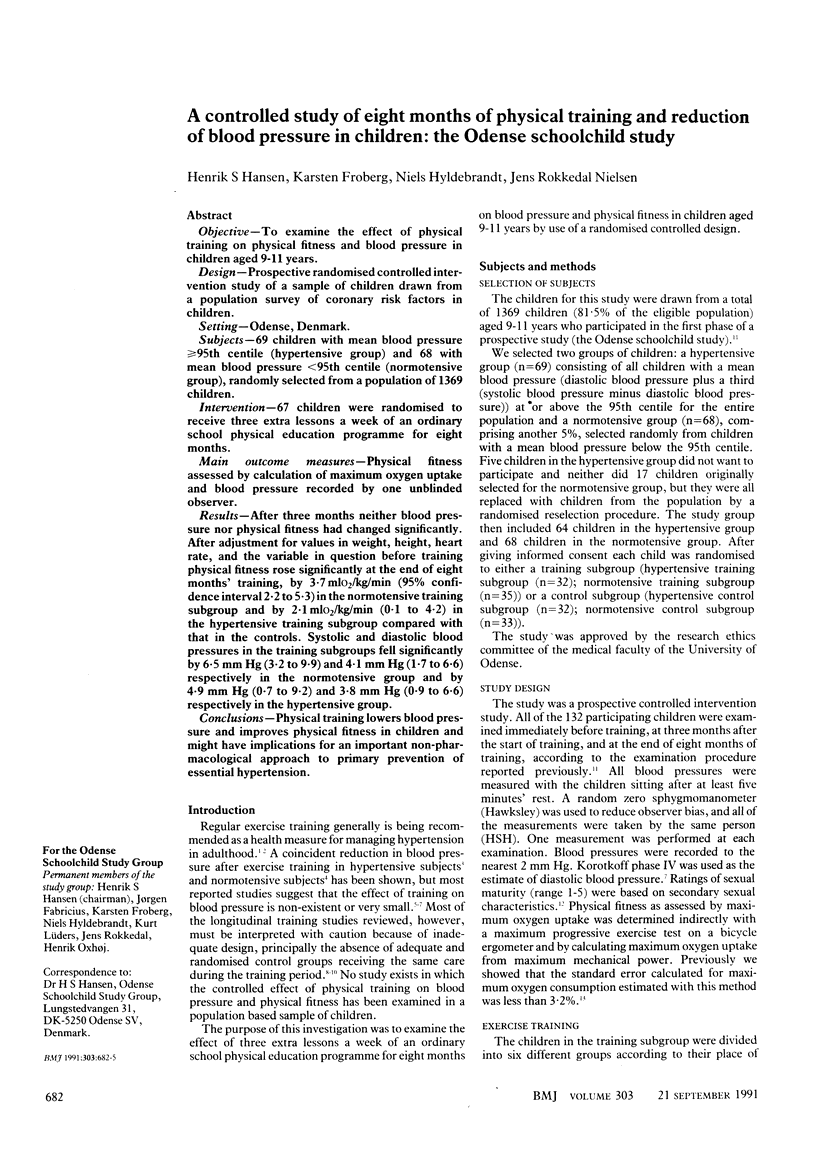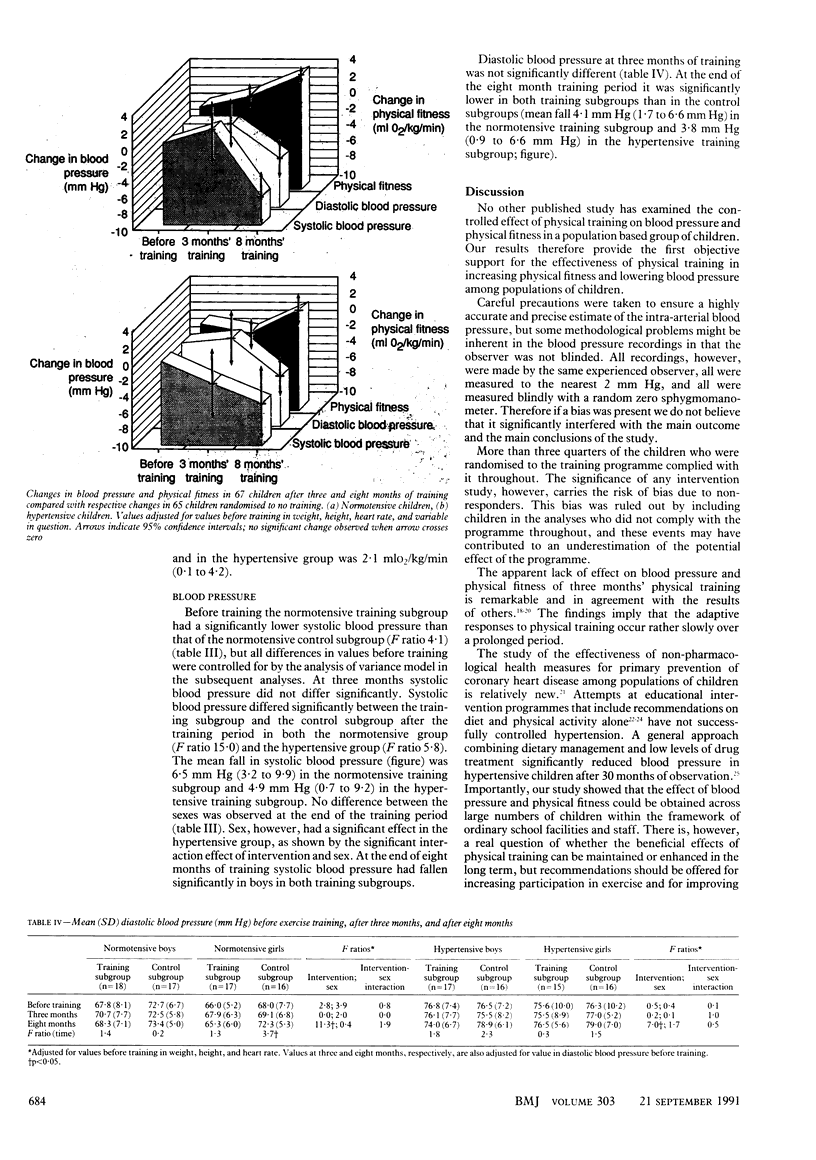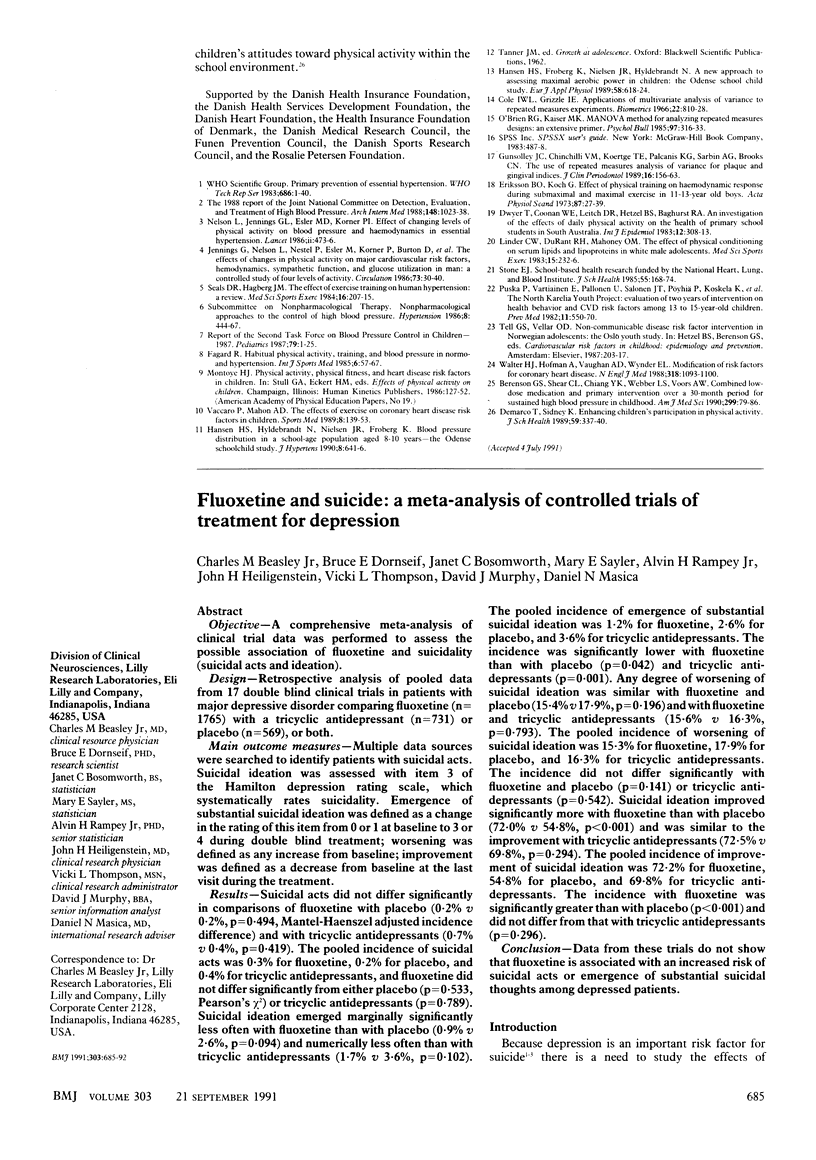Abstract
OBJECTIVE--To examine the effect of physical training on physical fitness and blood pressure in children aged 9-11 years. DESIGN--Prospective randomised controlled intervention study of a sample of children drawn from a population survey of coronary risk factors in children. SETTING--Odense, Denmark. SUBJECTS--69 children with mean blood pressure greater than or equal to 95th centile (hypertensive group) and 68 with mean blood pressure less than 95th centile (normotensive group), randomly selected from a population of 1369 children. INTERVENTION--67 children were randomised to receive three extra lessons a week of an ordinary school physical education programme for eight months. MAIN OUTCOME MEASURES--Physical fitness assessed by calculation of maximum oxygen uptake and blood pressure recorded by one unblinded observer. RESULTS--After three months neither blood pressure nor physical fitness had changed significantly. After adjustment for values in weight, height, heart rate, and the variable in question before training physical fitness rose significantly at the end of eight months' training, by 3.7 mlO2/kg/min (95% confidence interval 2.2 to 5.3) in the normotensive training subgroup and by 2.1 mlO2/kg/min (0.1 to 4.2) in the hypertensive training subgroup compared with that in the controls. Systolic and diastolic blood pressures in the training subgroups fell significantly by 6.5 mm Hg (3.2 to 9.9) and 4.1 mm Hg (1.7 to 6.6) respectively in the normotensive group and by 4.9 mm Hg (0.7 to 9.2) and 3.8 mm Hg (0.9 to 6.6) respectively in the hypertensive group. CONCLUSIONS--Physical training lowers blood pressure and improves physical fitness in children and might have implications for an important non-pharmacological approach to primary prevention of essential hypertension.
Full text
PDF



Selected References
These references are in PubMed. This may not be the complete list of references from this article.
- Berenson G. S., Shear C. L., Chiang Y. K., Webber L. S., Voors A. W. Combined low-dose medication and primary intervention over a 30-month period for sustained high blood pressure in childhood. Am J Med Sci. 1990 Feb;299(2):79–86. doi: 10.1097/00000441-199002000-00001. [DOI] [PubMed] [Google Scholar]
- DeMarco T., Sidney K. Enhancing children's participation in physical activity. J Sch Health. 1989 Oct;59(8):337–340. doi: 10.1111/j.1746-1561.1989.tb04739.x. [DOI] [PubMed] [Google Scholar]
- Dwyer T., Coonan W. E., Leitch D. R., Hetzel B. S., Baghurst R. A. An investigation of the effects of daily physical activity on the health of primary school students in South Australia. Int J Epidemiol. 1983 Sep;12(3):308–313. doi: 10.1093/ije/12.3.308. [DOI] [PubMed] [Google Scholar]
- Eriksson B. O., Koch G. Effect of physical training on hemodynamic response during submaximal and maximal exercise in 11-13-year old boys. Acta Physiol Scand. 1973 Jan;87(1):27–39. doi: 10.1111/j.1748-1716.1973.tb05363.x. [DOI] [PubMed] [Google Scholar]
- Fagard R. Habitual physical activity, training, and blood pressure in normo- and hypertension. Int J Sports Med. 1985 Apr;6(2):57–67. doi: 10.1055/s-2008-1025814. [DOI] [PubMed] [Google Scholar]
- Gunsolley J. C., Chinchilli V. M., Koertge T. E., Palcanis K. G., Sarbin A. G., Brooks C. N. The use of repeated measures analysis of variance for plaque and gingival indices. J Clin Periodontol. 1989 Mar;16(3):156–163. doi: 10.1111/j.1600-051x.1989.tb01633.x. [DOI] [PubMed] [Google Scholar]
- Hansen H. S., Froberg K., Nielsen J. R., Hyldebrandt N. A new approach to assessing maximal aerobic power in children: the Odense School Child Study. Eur J Appl Physiol Occup Physiol. 1989;58(6):618–624. doi: 10.1007/BF00418508. [DOI] [PubMed] [Google Scholar]
- Hansen H. S., Hyldebrandt N., Nielsen J. R., Froberg K. Blood pressure distribution in a school-age population aged 8-10 years: the Odense Schoolchild Study. J Hypertens. 1990 Jul;8(7):641–646. doi: 10.1097/00004872-199007000-00007. [DOI] [PubMed] [Google Scholar]
- Jennings G., Nelson L., Nestel P., Esler M., Korner P., Burton D., Bazelmans J. The effects of changes in physical activity on major cardiovascular risk factors, hemodynamics, sympathetic function, and glucose utilization in man: a controlled study of four levels of activity. Circulation. 1986 Jan;73(1):30–40. doi: 10.1161/01.cir.73.1.30. [DOI] [PubMed] [Google Scholar]
- Linder C. W., DuRant R. H., Mahoney O. M. The effect of physical conditioning on serum lipids and lipoproteins in white male adolescents. Med Sci Sports Exerc. 1983;15(3):232–236. [PubMed] [Google Scholar]
- Nelson L., Jennings G. L., Esler M. D., Korner P. I. Effect of changing levels of physical activity on blood-pressure and haemodynamics in essential hypertension. Lancet. 1986 Aug 30;2(8505):473–476. doi: 10.1016/s0140-6736(86)90354-5. [DOI] [PubMed] [Google Scholar]
- O'Brien R. G., Kaiser M. K. MANOVA method for analyzing repeated measures designs: an extensive primer. Psychol Bull. 1985 Mar;97(2):316–333. [PubMed] [Google Scholar]
- Puska P., Vartiainen E., Pallonen U., Salonen J. T., Pöyhiä P., Koskela K., McAlister A. The North Karelia youth project: evaluation of two years of intervention on health behavior and CVD risk factors among 13- to 15-year old children. Prev Med. 1982 Sep;11(5):550–570. doi: 10.1016/0091-7435(82)90068-8. [DOI] [PubMed] [Google Scholar]
- Seals D. R., Hagberg J. M. The effect of exercise training on human hypertension: a review. Med Sci Sports Exerc. 1984 Jun;16(3):207–215. [PubMed] [Google Scholar]
- Stone E. J. School-based health research funded by the National Heart, Lung, and Blood Institute. J Sch Health. 1985 May;55(5):168–174. doi: 10.1111/j.1746-1561.1985.tb04113.x. [DOI] [PubMed] [Google Scholar]
- Vaccaro P., Mahon A. D. The effects of exercise on coronary heart disease risk factors in children. Sports Med. 1989 Sep;8(3):139–153. doi: 10.2165/00007256-198908030-00002. [DOI] [PubMed] [Google Scholar]
- Walter H. J., Hofman A., Vaughan R. D., Wynder E. L. Modification of risk factors for coronary heart disease. Five-year results of a school-based intervention trial. N Engl J Med. 1988 Apr 28;318(17):1093–1100. doi: 10.1056/NEJM198804283181704. [DOI] [PubMed] [Google Scholar]


